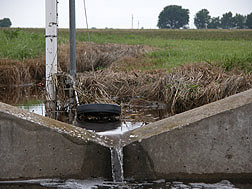This page has been archived and is being provided for reference purposes only. The page is no longer being updated, and therefore, links on the page may be invalid.
Read the magazine story to find out more. |
|
|
Precision Agriculture: Maximizing Benefits with Better Management
By Laura McGinnisMarch 14, 2007
Good cooks don't toss Worcestershire sauce in the ice cream or mint in the mashed potatoes. Instead, they season each dish with the best quantities and combinations of spices to enhance its natural flavor.
That's the concept behind precision agriculture, which is the practice of modifying management techniques to meet within-field variations that affect crop growth. Using an integrated approach, Agricultural Research Service (ARS) scientists in the Cropping Systems and Water Quality Research Unit (CSWQ) at Columbia, Mo., are determining which combinations of precision agriculture methods work best.
Using data collected between 1991 and 2003, researchers Newell Kitchen, Robert Lerch and Ken Sudduth determined that topsoil loss from field erosion significantly reduced agricultural productivity. They also discovered that elevation and soil electrical conductivity, which measures how easily soil allows an electrical current to flow through it, were extremely helpful in identifying different management zones. In fact, zone maps created with this information were more accurate predictors of crop yield than maps made with traditional soil surveys.
In addition, the CSWQ team developed two site-specific management approaches to help growers identify the fertilizer needs of specific areas within a field, allowing for more accurate application. The first method assesses nitrogen deficiency by measuring crop canopy reflectance. The second method, still in development, relies on an automated soil sample collection and analysis system, which could quickly and economically predict the soil's nitrogen-supplying capacity.
During the next five years, the researchers hope to show that their methods decrease nutrient and sediment losses, increase profitability and improve soil quality. Above all, they hope to demonstrate that precision agriculture can be an economically viable tool for farmers.
Read more about the research in the March 2007 issue of Agricultural Research magazine.
ARS is the chief in-house scientific research agency of the U.S. Department of Agriculture.

